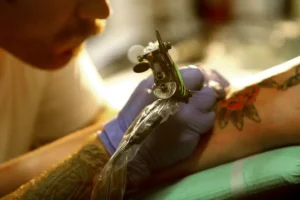
We now offer a more reasonable way of estimating the lives saved and the statistical value of those lives through a series of steps using the data summarized in Table 2 (see Appendix Table 6, for calculations). Total membership by age structure, knowing that people die at different rates according to age. We also know that people addicted to alcohol are much more likely to die than those who are not. We then apply the relative mortality rate to people with alcohol use disorder, which is estimated to be 3.45 higher than that of sober people (Laramée et al. 2015), and arrive at the excess deaths for each age-group, which would have occurred had it not been for A.A. Will stay sober and reduce their risk of death is unreasonable, given that some A.A. Adopting a conservative approach, we take into our calculation only A.A.

Behavioral Treatments
Below are samples of e-health tools developed with NIAAA funding. Both of these fee-based, self-guided programs have a research base that shows their potential to help people cut down or quit drinking. You can create a telehealth care team by combining a therapist with an addiction doctor for medications support. How can you tell if the providers you find offer higher-quality care that will meet your needs? We share both what questions to ask and how to listen for quality in the answers. Caring for a person who has problems with alcohol can be very stressful.
What professionally-led behavioral health treatments have been shown to be effective in treating AUD?
Our admissions navigators are available 24/7 to speak with you and there is no obligation to make any decisions right away. We’re here for you and are excited to be on this journey with you. According to the National Institute on Alcohol Abuse and Alcoholism (NIAAA), approximately 17 million American adults have an alcohol use disorder (AUD).20 But the good news is, no matter how severe the problem may seem, recovery is possible.
When Is It Time for Treatment?
If you or someone you care about is struggling with alcoholism and would like to learn more about treatment, American Addiction Centers (AAC) can help. Alcohol.org is a subsidiary of AAC, a nationwide provider of addiction treatment facilities. Healthcare professionals now provide up-to-date treatments backed by science. Care is offered at different levels of intensity in a variety of settings. Many outpatient options allow people to maintain their regular routines and their privacy, too, if desired.
- According to the National Institute on Alcohol Abuse and Alcoholism (NIAAA), approximately 17 million American adults have an alcohol use disorder (AUD).20 But the good news is, no matter how severe the problem may seem, recovery is possible.
- You may want to take a family member or friend along, if possible.
- They will help you learn whether a program offers higher-quality care and is a good fit for your situation.
- Based on our review of extensive evidence-based research on addiction that follows, it is clear that religion and spirituality—which we refer to collectively as faith—are exceptionally powerful, integral, and indispensable resources in substance abuse prevention and recovery.
- According to the US Department of Transportation (2016a), 10,265 people died in alcohol-induced car crashes, accounting for nearly one-third (29%) of all US traffic-related deaths.
These programs allow someone to completely focus on their recovery. They have medical staff on hand to monitor and treat withdrawal symptoms. This guide is written for individuals, and their family and friends, who are looking for options to address alcohol problems.

RESOURCES

These are phone or video sessions for talk therapy or medical care. They can be particularly useful in locations with few addiction health professionals. There are even accredited, all-telehealth alcohol treatment programs.
- In addition to in-person options, you can access alcohol treatmentthrough telehealth services and other online options.Learn how to find quality care for yourself or a loved one or for patients or clients.
- The National Institute on Alcohol Abuse and Alcoholism (NIAAA) is supporting research to identify genetic, behavioral, and other factors that can predict how well someone will respond to a particular treatment.
- Federal competitive funding won by faith-based and secular nonprofit organizations (NPOs).
- The evidence suggests that the free and flexible assistance provided by mutual-support groups can help people make and sustain beneficial changes and, thus, promote recovery.
- Specifically, this study’s middle estimate of $237.9 billion for substance abuse programs alone is 33% higher than their total individual social impact category.
- This activity provides 0.75 CME/CE credits for physicians, physician assistants, nurses, pharmacists, and psychologists, as well as other healthcare professionals whose licensing boards accept APA or AMA credits.
- These include FDA-approved medications, behavioral therapy, and mutual-support groups.
- International studies provide corroborative support for US findings, linking religious participation and a personal prayerful connection with God (or spirituality) to fewer addictive behaviors (e.g., Szaflarski 2001; Gomes et al. 2013; Haug et al. 2014).
- The CEA took this non-fatal total cost of $58.0 billion and divided it by the 1.9 million individuals who had a prescription opioid disorder in 2013 (the reference year of Florence et al. (2016) study), resulting in an average cost of approximately $30,000 per person.
- Into the framework of the doctrines, principles, and beliefs of the Church (The Church of Jesus Christ Latter-day Saints 2018).
- An emphasis on the biological aspect of healing has provided us with advanced diagnostics, safe surgery, and an extended lifespan; the benefits have been extraordinary.
The study did not, however, conduct a valuation of each type of community service, but rather used an algorithm based on in-depth studies of individual congregations by Cnaan et al. (1999, 2006, 2013) and Cnaan (2015). Johnson (2016) argued, however, that while the study was valuable and groundbreaking, it undervalued the economic impact of religion. Lifesaving medicines and psychological interventions are important parts of rescue and recovery; however, they are not enough. Religion and religious participation can address the many issues that lead people to alcohol and/or drug dependency that medical interventions alone can fail to address. The evidence we have reviewed and presented above shows that religious beliefs, practices, and belonging as well as spiritual programs inspired by faith in a Higher Being significantly contribute to the prevention of and recovery from substance abuse.
Starting with a Primary Care Provider
Inpatient recovery is intensive and requires overnight stays at a facility. It can be a good choice for Alcoholism Treatment Program people seeking around-the-clock support during withdrawal and those with co-occurring mental health conditions. The Navigator can help you find some mutual-support groups to consider. You can find more recovery support options from the American Society of Addiction Medicine’s list of online support groups, apps, and podcasts.
There is no one-size-fits-all solution, and often, understanding the different options can facilitate the choice. Read on to find out more on each of https://ecosoberhouse.com/article/addiction-vs-dependence-what-is-the-difference/ the different types of treatment for alcoholism and how to get help. This activity provides 0.75 CME/CE credits for physicians, physician assistants, nurses, pharmacists, and psychologists, as well as other healthcare professionals whose licensing boards accept APA or AMA credits. More resources for a variety of healthcare professionals can be found in the Additional Links for Patient Care. Findings from studies on the impact of faith on substance abuse.
Alcohol use disorder care at Mayo Clinic
Professionally led alcohol treatment now takes place in a variety of settings, including outpatient care that can help many people recover while still living at home. Whether it’s for you or someone you love, choosing where to seek alcohol treatment, what type of care you need, and what daily life will look like post-treatment can make the process seem even more challenging. However, there are a number of alcohol treatment options available for those in need, ranging from medical detox to residential inpatient, partial hospitalization, intensive outpatient, and standard outpatient treatment programs.
